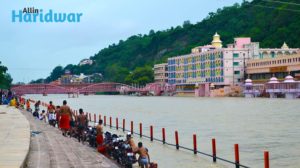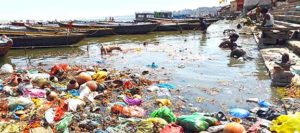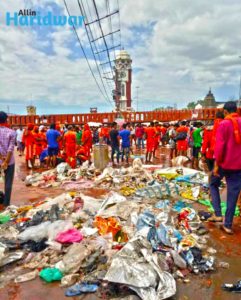Pollution in holy river Ganga and generally in any river, had been the source of great concern for the environmental scientist. Reasons being so many that it’s hard to keep it on religious terms that why should we respect Holy Ganga and treat her like a mother or at least life giving the source of fresh water.
 In ancient times, sages and saints all talked in length about the benefit of natural resources found in Himalayas especially the spiritual and medicinal qualities of rivers, herbs, certain trees, and animals. We take them as mere representation of their religious beliefs and do not really look into the matter as a necessity. Their goal was to make us feel as connected as possible to these life giving sources, so that we would take care of them in all conditions.
In ancient times, sages and saints all talked in length about the benefit of natural resources found in Himalayas especially the spiritual and medicinal qualities of rivers, herbs, certain trees, and animals. We take them as mere representation of their religious beliefs and do not really look into the matter as a necessity. Their goal was to make us feel as connected as possible to these life giving sources, so that we would take care of them in all conditions.
As we know in the universe we all are connected by unseen forces, and yet we feel separated by physical activities that we do. Same is with the people who are in living around or close to a river would know that it’s the only source of fresh water and they are the consumers, still wouldn’t see that how their garbage, sewer waste is affecting the freshness of water.
The main causes of water pollution in the Ganga river are:
The increase in the population density, various human activities (such as bathing, washing clothes, and the bathing of animals), and dumping of various harmful industrial waste into the river.
 According to Wikipedia, a 2006 measurement of pollution in the Ganga revealed that river water monitoring over the previous 12 years had demonstrated fecal coliform counts up to 100,000,000 MPN (most probable number) per 100 ml[citation needed] and biological oxygen demand levels averaging over 40 mg/l in the most polluted part of the river in Varanasi. The overall rate of water-borne/enteric disease incidence, including acute gastrointestinal disease, was estimated to be about 66%.” This is overwhelming for religious sentiments and also for those who care about their health more than religion.
According to Wikipedia, a 2006 measurement of pollution in the Ganga revealed that river water monitoring over the previous 12 years had demonstrated fecal coliform counts up to 100,000,000 MPN (most probable number) per 100 ml[citation needed] and biological oxygen demand levels averaging over 40 mg/l in the most polluted part of the river in Varanasi. The overall rate of water-borne/enteric disease incidence, including acute gastrointestinal disease, was estimated to be about 66%.” This is overwhelming for religious sentiments and also for those who care about their health more than religion.
That being said, I would like to mention the environmental threat which Holy River Ganga faces by this lack of knowledge on our side.
1. Marine Life
The results of mercury analysis in various specimens collected along the basin indicated that some fish muscles tended to accumulate high levels of mercury. Which is harmful for fishes as well as those who acquire them from the river for food.
The Ganges river dolphin is also a victim of the pollution in Ganga, and they are listed as endangered species. Hydroelectric and irrigation dams along the Ganga that prevents the dolphins from travelling up and down river is the main reason for their reducing population.
Soft shelled tortoise are found in the Ganges, inhabits deep rivers, streams, large canals, lakes and ponds, with a bed of mud or sand.
Due to their long lifespan and high trophic level in the aquatic food web, turtles are vulnerable to heavy metals pollution, a major kind of pollution in the Ganges.
2. Wildlife
Some of the dams being constructed along the Ganga basin will submerge substantial areas of nearby forest. For example, the Kotli-Bhel dam at Devprayag will submerge 1200 hectares of forest, wiping out the river otters and the mahaseer fish that are found there. There are plans for 300 dams all over the river and this is some serious problem for the same reason.
3.Human beings
An analysis of the Ganga water in 2006 and 2007 showed significant associations between water-borne/enteric disease pop and the use of the river for bathing, laundry, washing, eating, cleaning utensils, and brushing teeth.
Water in the Ganga has been correlated to contracting dysentery, cholera, hepatitis, as well as severe diarrhoea which continues to be one of the leading causes of death of children in India.
We cannot even imagine the Holy River which is supposed to wash away our sins, to make us so sick, as to cause death. Neither we could imagine the large areas of valleys and Plains without forest with sand shining on the surface of dry river beds, to heat up the whole space.
Height of Himalaya washed away our spiritual sufferings, and provided us with food and water, and developed us as a civilization.
Neglecting the welfare of largest river of India might lead to infertilization of soil and also take away the source of income, on which many villages and cities are thriving and developing.
Water being the 70 percent part of our body is indeed a holy element as it keeps us flexible and alive. Polluting water is itself an act of irresponsibility and we must take some action to stop it.
Some of the actions which we may take without having to join the ongoing projects while visiting Haridwar and Rishikesh is by not throwing plastic, water bottles or any other garbage in River and by keeping the banks clean too.
Please don’t take it lightly, because even if floods comes in a River, fresh water is still like gold, ‘limited and precious’.
Trish Angel
Latest posts by Trish Angel (see all)
- Life along the Holy River Ganga… - September 3, 2017
- Law Of Attraction and Love - June 7, 2016
- Time was born in the mind of a doer - April 19, 2016
